
As I explore the upper lats or latissimus dorsi muscles, I recognize their crucial role in maintaining shoulder mobility and back stability.
Stretching these muscles is essential for enhancing flexibility and preventing injuries arising from tightness or imbalances.
In this post, I will share effective upper lats stretches targeting these important muscles.
Additionally, I will discuss various ways I incorporate specific lat exercises into my daily routine, helping me improve flexibility, enhance performance, and reduce the risk of injuries associated with tight lats and limited mobility.
Best Stretches and Lat Exercises for Upper Lats
Here are some of my favorite stretches specifically designed to effectively target the upper lats:
1. Latissimus Dorsi Stretch
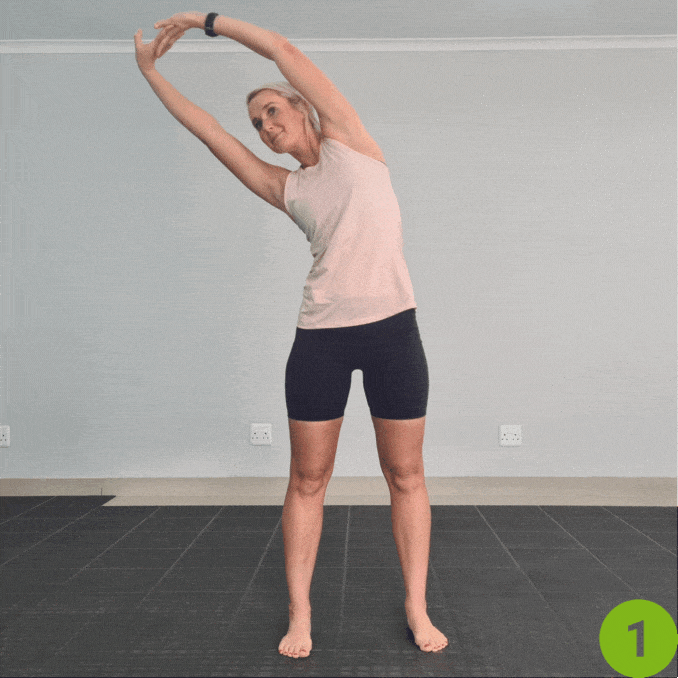
- Begin in an upright standing position with your feet hip-width apart, maintaining good alignment with your head, shoulders, hips, and legs.
- Engage your core and slightly bend your body towards the right side until you feel a gentle stretch on the left side.
- Hold this position for one to two full breaths, then return to the starting position.
- Repeat on the opposite side.
- Keep alternating between these two sides.
- Complete 10 repetitions, 1-2 sets.
2. Child’s Pose
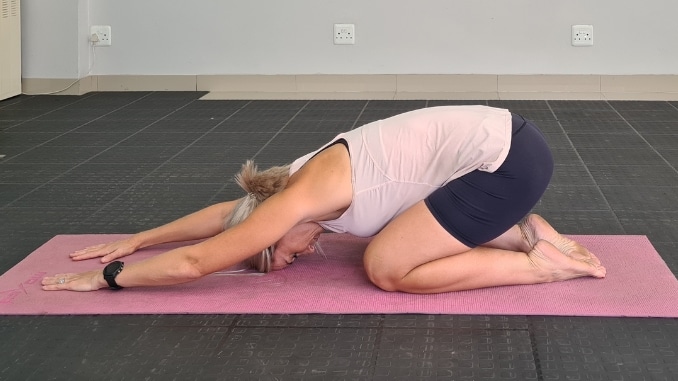
- Begin in an upright kneeling position with your knees wider than the shoulder-width apart and your big toes touching each other.
- Engage your core.
- Shift your hips back to your feet and extend your arms in front.
- Drop your forehead down, relaxing your mid-back area for a light stretch.
- Then, take some deep belly breaths through your nose and out through your mouth.
- Hold this position for a few seconds.
- Relax and return to the starting position.
3. Wide Arm Side Bend
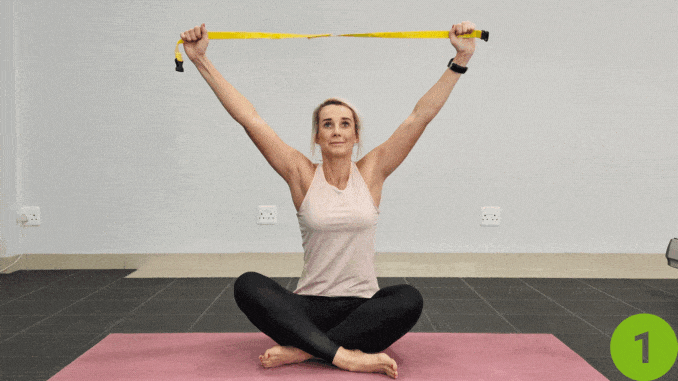
- Begin in an upright sitting position on the floor with your legs crossed in front of your body, maintaining good alignment with your head, shoulders, and hips.
- Hold the ends of the yoga strap in both hands, with your arms overhead and wide apart, creating resistance on the strap.
- Engage your core and bend your upper body to the side, maintaining tension on the yoga strap.
- Hold this position for a few seconds with several deep belly breaths, in through your nose and out through your mouth.
- Return to the starting position and repeat the movement on the opposite side.
4. Thread the Needle
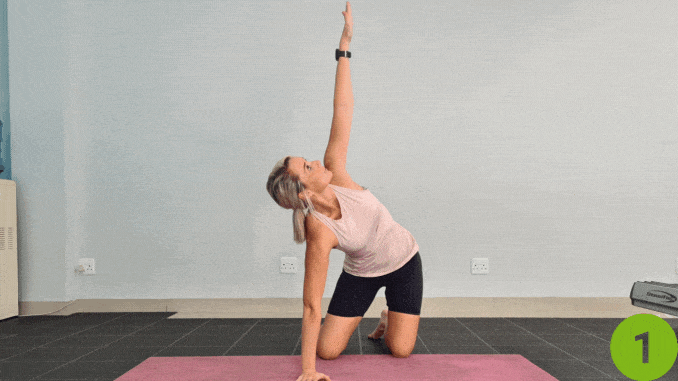
- Begin in a 4-point position with your hands beneath your shoulders and your knees under your hips.
- Then, inhale as you extend your left arm towards the ceiling, keeping your gaze upward.
- Exhale and slide the same hand under your supporting arm with your palm facing upward.
- Lower your shoulder to the floor and rest your head on the floor.
- Moreover, hold the position for a couple of seconds.
- Return to the starting position and repeat the movement on the opposite side.
These stretches help maintain flexibility and prevent tightness, enhancing overall shoulder mobility.
Advanced Upper Lats Stretches
For those looking to enhance their upper lats strength and flexibility [2] further, here are some advanced exercises I recommend:
- Wide Grip Pull-Ups – Using an overhand grip, grasp the pull-up bar with your hands positioned wider than shoulder-width apart. This targets the upper lats intensely as you pull your chin above the bar.
- Chin Ups – Using a neutral grip, grasp the pull-up bar with your palms facing towards you and hands shoulder-width apart. This variation effectively engages the upper lats while also incorporating the biceps.
- Lat Pull-Down Machine – Sit at the lat pulldown machine and grasp the bar with an overhand grip, wider than shoulder-width. Pull the bar down towards your chest, focusing on squeezing your shoulder blades together to engage it effectively.
- Straight Arm Pull Downs – Stand before a cable machine with a straight bar attachment. Using an overhand grip, pull the bar down towards your thighs while keeping your arms straight. Focus on engaging your lats as you perform the movement.
- Seated Rows – Using a cable machine, sit with your feet secured and pull the handle towards your torso. Depending on the grip, you can use either an overhand or neutral grip to target the upper lats and upper back effectively.
How to Target Upper Lats
To effectively target your upper lats, focus on exercises that engage these muscles directly. Here are some movements I recommend:
- Pull-Ups: A great way to activate and strengthen the upper lats.
- Wide Grip Pull Downs: Using a cable machine with a wide grip, this exercise allows you to isolate the lats effectively, enhancing their development and strength.
- Seated Rows: This movement targets the lats while engaging the upper back and shoulders.
- Chin-Ups: Similar to pull-ups, chin-ups also effectively engage the upper lats while involving the biceps, making them an excellent compound movement for upper body development.
Maintaining proper form is crucial for maximizing the benefits of these exercises and minimizing the risk of injury. Always ensure your shoulders are retracted, and avoid swinging your body during the movements.
Levels of Upper Lats Stretches
- Level 1 Basic Stretch: This level involves simple stretches that require minimal flexibility and are easy to perform. They help introduce the concept the concept of stretching the upper lats and are suitable for beginners.
- Level 2 Intermediate Stretch: Intermediate stretches involve more engagement and a greater range of motion. They require more flexibility and strength compared to level 1, targeting the lats more effectively.
- Level 3 Advanced Stretch: Advanced stretches involved complex movements and require a high level of flexibility and strength. These stretches engage multiple muscle groups and provide a deeper stretch, promoting significant mobility and release of tension in the upper lats.
This structure allows for a progressive approach to stretching, catering to various levels of fitness and flexibility.
Understanding Upper Lats
Incorporating these exercises into your routine can help build strength and flexibility in your upper lats, contributing to overall upper body performance.
The upper lats are the large muscles located on the sides of your back, extending from the lower spine to the upper arm. These muscles are vital for various movements, including pulling and lifting. The shoulder blades play a crucial role in upper lats movements, as retracting and squeezing them ensures effective muscle engagement and proper form.
Understanding the distinction between the upper and lower lats is important; the upper lats contribute to shoulder extension and adduction, while the lower lats assist in spinal extension and stabilization. Maintaining flexibility in the upper lats helps prevent issues such as shoulder pain, back discomfort, and limited mobility.
Tight upper lats can lead to muscle imbalances, affecting posture and overall physical performance.
Anatomy of the Upper Lats
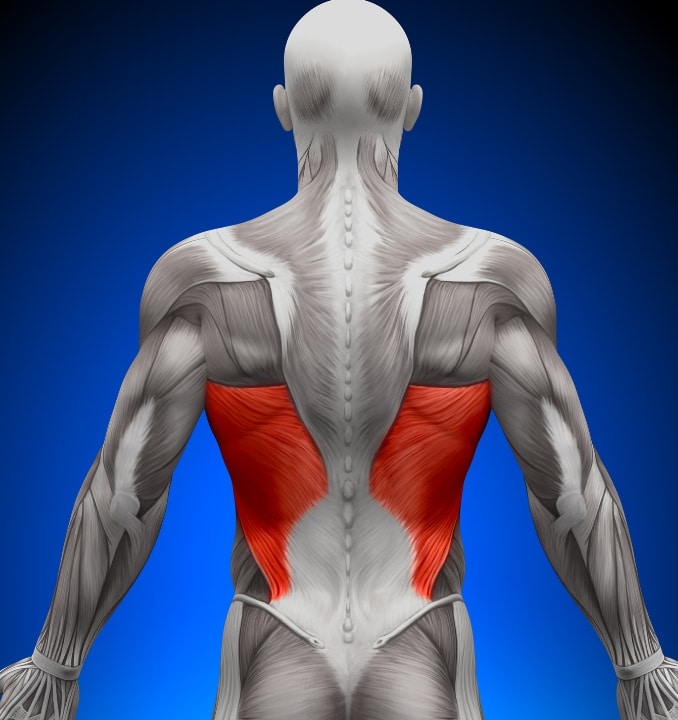
The upper lats, or latissimus dorsi muscles [1], are a key component of your back muscles. These muscles span from the lower spine to the upper arm, playing a pivotal role in movements that involve pulling the arms toward the body. The latissimus dorsi muscle fibers are oriented horizontally, allowing for a wide range of motion and making them essential for various upper body activities.
These muscles attach to the humerus (upper arm bone) and the scapula (shoulder blade), working in tandem with the teres major and pectoralis major muscles. This collaboration enables actions such as adduction, medial rotation, and arm extension at the glenohumeral joint.
Understanding the anatomy of the upper lats is crucial for designing effective workouts that maximize muscle engagement and promote comprehensive lat development.
Benefits of Stretching the Upper Lats
Incorporating upper lat stretches into your fitness routine can yield numerous benefits, enhancing both your physical performance and overall well-being. Here are some key advantages:
- Improved Flexibility and Range of Motion: Regular stretching helps maintain and increase the flexibility of the latissimus dorsi, allowing for a greater range of motion in your shoulders and upper back.
- Reduced Muscle Soreness and Injury Risk: Stretching can alleviate muscle tightness and soreness, reducing the likelihood of strains and other injuries.
- Enhanced Posture and Reduced Back Pain: Flexible upper lats contribute to better posture, which can help alleviate back pain and discomfort.
- Increased Muscle Engagement and Strength: Stretching prepares your muscles for more effective engagement during lats workout, improving strength and performance.
Boosted Athletic Performance: Enhanced flexibility and strength in the upper lats can translate to better performance in various sports and physical activities.
By regularly stretching your upper lats, you can promote lat development and improve your overall fitness, making these stretches a valuable addition to any workout routine.
Common Mistakes to Avoid When Stretching the Upper Lats

When I stretch my upper lats, avoiding common mistakes is crucial for effectiveness and safety. Here are some pitfalls I make sure to watch out for:
- Not Warming Up Properly: Always warm up your muscles before stretching to prevent injuries. A light cardio session or dynamic stretches can prepare your muscles for deeper stretching.
- Stretching Too Aggressively or Bouncing: Stretch gently and avoid bouncing, which can cause muscle strains. Instead, hold each stretch steadily within a comfortable range.
- Not Holding the Stretch Long Enough: To reap the benefits, hold each stretch for at least 15-30 seconds. This duration allows the muscle fibers to lengthen and relax.
- Inconsistent Stretching Routine: Regularity is key. Stretching sporadically won’t yield the same benefits as a consistent routine.
- Incorrect Muscle Targeting: Ensure you’re targeting the upper lats specifically. Proper form and technique are essential for effective stretching.
By being mindful of these common mistakes, you can perform upper lat stretches safely and effectively, maximizing their benefits.
Incorporating Upper Lats Stretches and Shoulder Blades into Daily Life
Integrating upper lats stretches into your daily routine can significantly improve flexibility and reduce tension. Aim to stretch at least 3-4 times a week, focusing on different levels based on your comfort and flexibility.
Consider doing these stretches during breaks at work or before and after workouts to promote muscle recovery.
The Role of Upper Lat Stretches in Injury Prevention
Upper lat stretches are not just about flexibility; they are vital in injury prevention. Regularly stretching the upper lats can help reduce muscle soreness, improve range of motion, and promote overall back development, all contributing to a lower risk of injuries.
Incorporating upper lat stretches into your workout routine can help prevent common injuries such as shoulder impingement, rotator cuff strains, and back strains. By targeting the upper lats from different angles and promoting both flexibility and strength, you can enhance your overall athletic performance and reduce the likelihood of injury.
Conclusion
Stretching your upper lats is essential for maintaining flexibility, improving posture, and preventing discomfort in your shoulders and upper back. I recommend incorporating these stretches into your fitness routine regularly, as they can significantly enhance your overall well-being, increase your range of motion, and boost your athletic performance.
It’s important to listen to your body and find the level of stretching that works best for you, whether you’re a beginner or more advanced. By making upper lats stretches a consistent part of your regimen, you can promote better muscle recovery, reduce tension, and support a healthy, active lifestyle.
What if I told you 11 gentle stretches could help you increase your energy, lose weight, decrease pain, stiffness and stress, and make you happier? Check out this 11 Daily Stretches to Feel and Look Amazing now!
Frequently Asked Questions
What are the upper lats?
The upper lats (latissimus dorsi) are large back muscles that support shoulder movement and stability, and they are important for pulling and lifting motions.
How do you work your upper lats?
Exercises like pull-ups, wide-grip pulldowns, seated rows, and chin-ups effectively target and strengthen the upper lats.
How do you target lower vs. upper lats?
For upper lats, use wide-grip pull-ups and lat pulldowns, and exercises like deadlifts or low rows for lower lats, focusing on spinal extension.
What grip works the upper lats?
A wide, overhand grip is ideal for engaging the upper lats during pull-ups, pulldowns, and similar movements.

